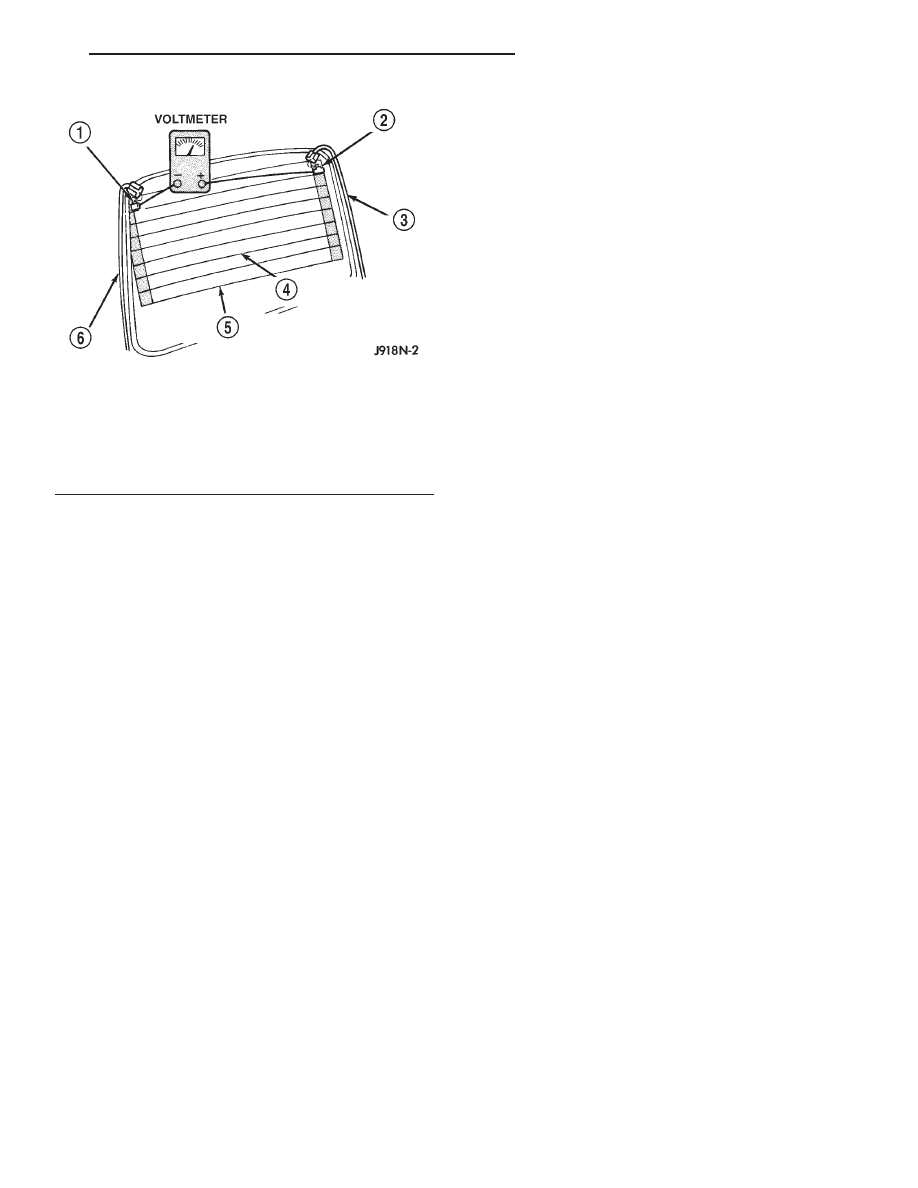Dodge Durango (DN). Manual - part 310

If the defogger system does not operate, the prob-
lem should be isolated in the following manner:
(1) Confirm that the ignition switch is in the On
position.
(2) Ensure that the rear glass heating grid feed
and ground wires are connected to the glass. Confirm
that the ground wire has continuity to ground.
(3) Check the fuses in the Power Distribution Cen-
ter (PDC) and in the junction block. The fuses must
be tight in their receptacles and all electrical connec-
tions must be secure.
When the above steps have been completed and the
rear glass heating grid is still inoperative, one or
more of the following is faulty:
• Rear window switch pod
• Rear window grid lines (all grid lines would
have to be broken or one of the feed wires discon-
nected for the entire system to be inoperative).
If setting the defogger switch to the On position
produces a severe voltmeter deflection, check for a
short circuit between the rear window switch pod
defogger relay output and the rear glass heating grid.
REAR GLASS HEATING GRID
For circuit descriptions and diagrams, refer to
8W-48 - Rear Window Defogger in Group 8W - Wir-
ing Diagrams. To detect breaks in the grid lines, the
following procedure is required:
(1) Turn the ignition switch to the On position. Set
the defogger switch in the On position. The indicator
lamp should light. If OK, go to Step 2. If not OK, see
Defogger Switch in the Diagnosis and Testing section
of this group.
(2) Using a 12-volt DC voltmeter, contact the ver-
tical bus bar on the right side of the vehicle with the
negative lead. With the positive lead, contact the ver-
tical bus bar on the left side of the vehicle. The volt-
meter should read battery voltage. If OK, go to Step
3. If not OK, repair the open circuit to the defogger
relay as required.
(3) With the negative lead of the voltmeter, contact
a good body ground point. The voltage reading should
not change. If OK, go to Step 4. If not OK, repair the
circuit to ground as required.
(4) Connect the negative lead of the voltmeter to
the right side bus bar and touch each grid line at
midpoint C with the positive lead. A reading of
approximately six volts indicates a line is good. A
reading of zero volts indicates a break in the grid
line between midpoint C and the left side bus bar. A
reading of ten to fourteen volts indicates a break
between midpoint C and the right side bus bar. Move
the positive lead on the grid line towards the break
and the voltage reading will change as soon as the
break is crossed.
DEFOGGER SWITCH
For circuit descriptions and diagrams, refer to
8W-48 - Rear Window Defogger in Group 8W - Wir-
ing Diagrams.
WARNING: ON VEHICLES EQUIPPED WITH AIR-
BAGS,
REFER
TO
GROUP
8M
-
PASSIVE
RESTRAINT SYSTEMS BEFORE ATTEMPTING ANY
STEERING
WHEEL,
STEERING
COLUMN,
OR
INSTRUMENT PANEL COMPONENT DIAGNOSIS OR
SERVICE. FAILURE TO TAKE THE PROPER PRE-
CAUTIONS COULD RESULT IN ACCIDENTAL AIR-
BAG DEPLOYMENT AND POSSIBLE PERSONAL
INJURY.
(1) Disconnect and isolate the battery negative
cable. Remove the lower bezel from the instrument
panel and unplug the rear window switch pod wire
harness connector.
(2) Check for continuity between the ground cir-
cuit cavity of the rear window switch pod wire har-
ness connector and a good ground. There should be
continuity. If OK, go to Step 3. If not OK, repair the
open circuit as required.
(3) Connect the battery negative cable. Check for
battery voltage at the fused B(+) circuit cavity of the
rear window switch pod wire harness connector. If
OK, go to Step 4. If not OK, repair the circuit to the
Power Distribution Center (PDC) fuse as required.
(4) Turn the ignition switch to the On position.
Check for battery voltage at the fused ignition switch
output (run) circuit cavity of the rear window switch
pod wire harness connector. If OK, go to Step 5. If
Fig. 1 Rear Window Glass Grid Test
1 – TERMINAL “A”
2 – TERMINAL “B”
3 – FEED WIRE
4 – MID-POINT “C” (TYPICAL)
5 – HEATED REAR WINDOW DEFOGGER GRID
6 – GROUND WIRE
DN
ELECTRICALLY HEATED SYSTEMS
8N - 3
DIAGNOSIS AND TESTING (Continued)